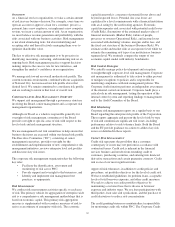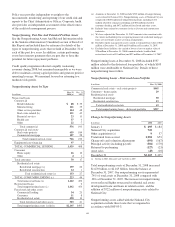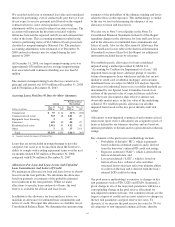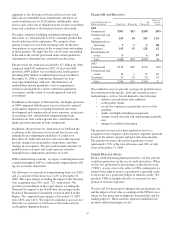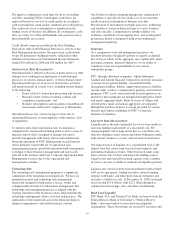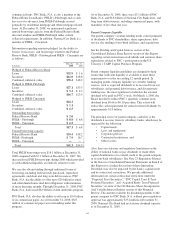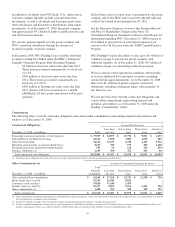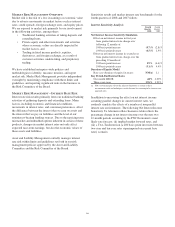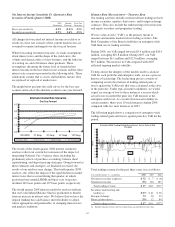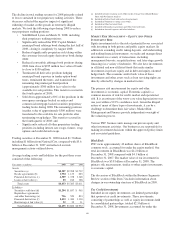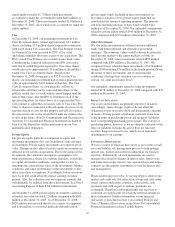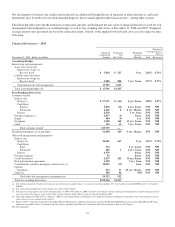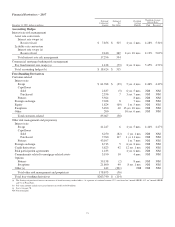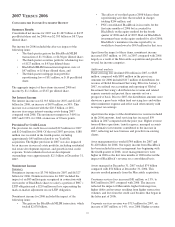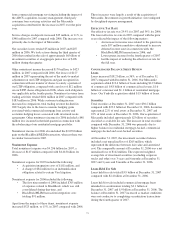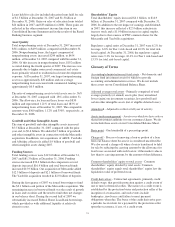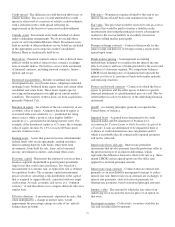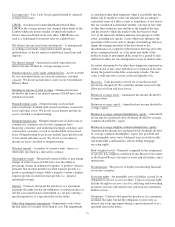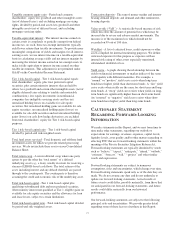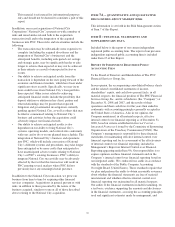PNC Bank 2008 Annual Report Download - page 73
Download and view the complete annual report
Please find page 73 of the 2008 PNC Bank annual report below. You can navigate through the pages in the report by either clicking on the pages listed below, or by using the keyword search tool below to find specific information within the annual report.equity method totaled $1.7 billion while investments
accounted for under the cost method totaled $648 million at
December 31, 2008. These investments totaled $1.0 billion at
December 31, 2007, all of which were accounted for under the
equity method.
Visa
At December 31, 2008, our remaining investment in Visa
Class B common shares totaled approximately 23.2 million
shares, including 19.7 million shares acquired in connection
with our National City acquisition. The Visa B shares owned
by National City were recorded by PNC at fair value
(including a liquidity discount) as part of our acquisition. The
PNC-owned Visa B shares are recorded at zero book value.
Considering the expected reduction in the IPO conversion
ratio due to settled litigation reported by Visa, these shares
would convert to approximately 14.6 million of the publicly
traded Visa Class A common shares. Based on the
December 31, 2008 closing price of $52.45 for the Visa
shares, our remaining investment had an unrecognized pretax
value of approximately $312 million at that date. The Visa
Class B common shares we own generally will not be
transferable until they can be converted into shares of the
publicly traded class of stock, which cannot happen until the
later of three years after the IPO or settlement of all of the
specified litigation. As stated above, it is expected that Visa
will continue to adjust the conversion ratio of Visa Class B to
Class A shares in connection with settlements in excess of any
amounts then in escrow for that purpose and will also reduce
the conversion ratio to the extent that it adds any funds to the
escrow in the future. Note 25 Commitments and Guarantees in
our Notes To Consolidated Financial Statements included in
Item 8 of this Report has further information on our Visa
indemnification obligation.
Private Equity
The private equity portfolio is comprised of equity and
mezzanine investments that vary by industry, stage and type
of investment. Private equity investments are reported at fair
value. Changes in the values of private equity investments are
reflected in our results of operations. Due to the nature of the
investments, the valuations incorporate assumptions as to
future performance, financial condition, liquidity, availability
of capital, and market conditions, among other factors, to
determine the estimated fair value of the investments. Market
conditions and actual performance of the investments could
differ from these assumptions. Accordingly, lower valuations
may occur that could adversely impact earnings in future
periods. Also, the valuations may not represent amounts that
will ultimately be realized from these investments. See Note 1
Accounting Policies in Item 8 for additional information.
At December 31, 2008, private equity investments carried at
estimated fair value totaled $1.2 billion compared with $561
million at December 31, 2007. As of December 31, 2008,
$620 million was invested directly in a variety of companies
and $566 million was invested indirectly through various
private equity funds. Included in direct investments are
investment activities of two private equity funds that are
consolidated for financial reporting purposes. The minority
and noncontrolling interests of these funds totaled $142
million as of December 31, 2008. Our unfunded commitments
related to private equity totaled $540 million at December 31,
2008 compared with $270 million at December 31, 2007.
Other Investments
We also make investments in affiliated and non-affiliated
funds with both traditional and alternative investment
strategies. The economic values could be driven by either the
fixed-income market or the equity markets, or both. At
December 31, 2008, other investments totaled $853 million
compared with $384 million at December 31, 2007. We
recognized losses related to these investments of $156 million
during 2008 including $76 million in the fourth quarter. Given
the nature of these investments and if current market
conditions affecting their valuation were to continue or
worsen, we could incur future losses.
Our unfunded commitments related to other investments
totaled $178 million at December 31, 2008 compared with $79
million at December 31, 2007.
I
MPACT OF
I
NFLATION
Our assets and liabilities are primarily monetary in nature.
Accordingly, future changes in prices do not affect the
obligations to pay or receive fixed and determinable amounts
of money. During periods of inflation, monetary assets lose
value in terms of purchasing power and monetary liabilities
have corresponding purchasing power gains. The concept of
purchasing power, however, is not an adequate indicator of the
effect of inflation on banks because it does not take into
account changes in interest rates, which are an important
determinant of our earnings.
F
INANCIAL
D
ERIVATIVES
We use a variety of financial derivatives as part of the overall
asset and liability risk management process to help manage
interest rate, market and credit risk inherent in our business
activities. Substantially all such instruments are used to
manage risk related to changes in interest rates. Interest rate
and total return swaps, interest rate caps and floors and futures
contracts are the primary instruments we use for interest rate
risk management.
Financial derivatives involve, to varying degrees, interest rate,
market and credit risk. For interest rate swaps and total return
swaps, options and futures contracts, only periodic cash
payments and, with respect to options, premiums are
exchanged. Therefore, cash requirements and exposure to
credit risk are significantly less than the notional amount on
these instruments. Further information on our financial
derivatives is presented in Note 1 Accounting Policies and
Note 17 Financial Derivatives in the Notes To Consolidated
Financial Statements in Item 8 of this Report.
69


